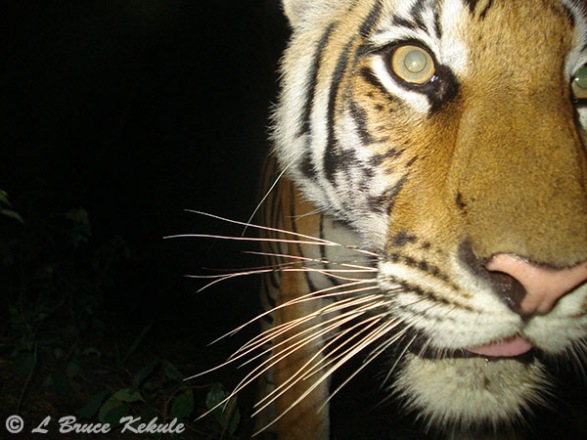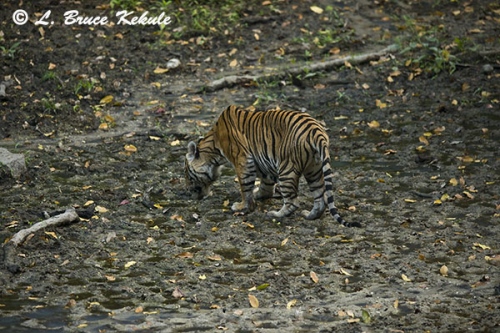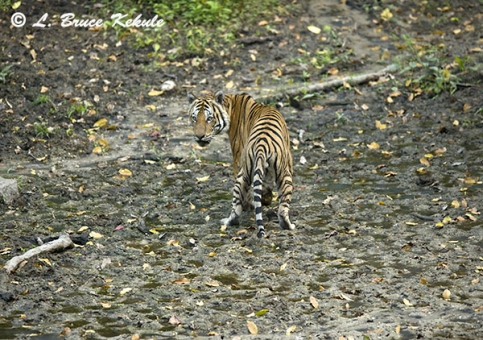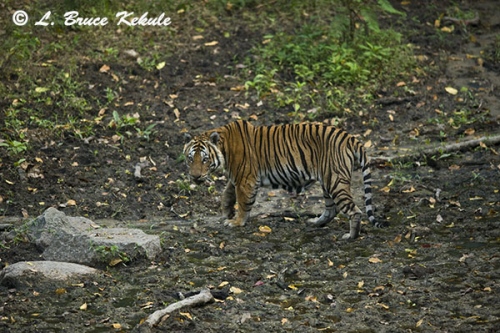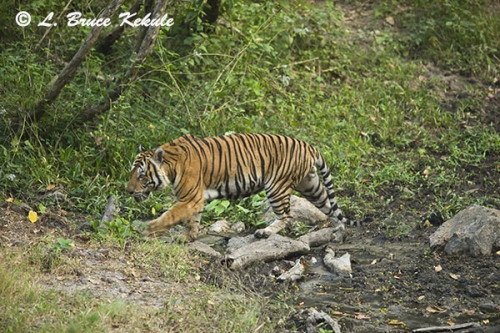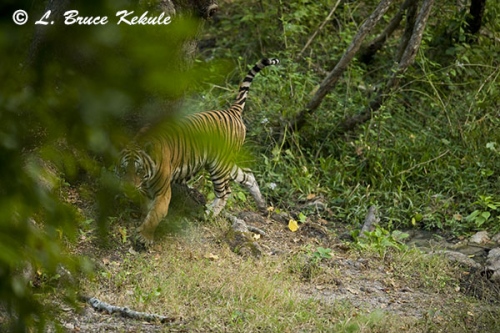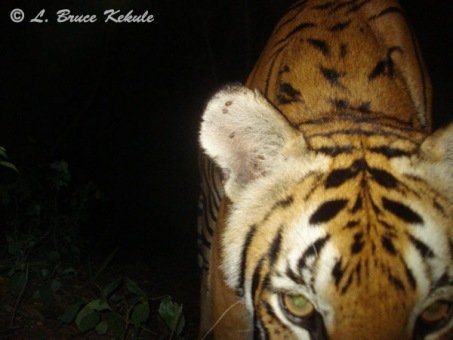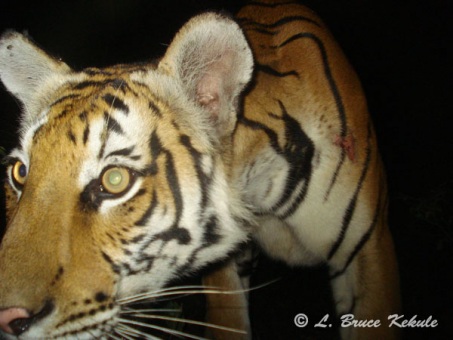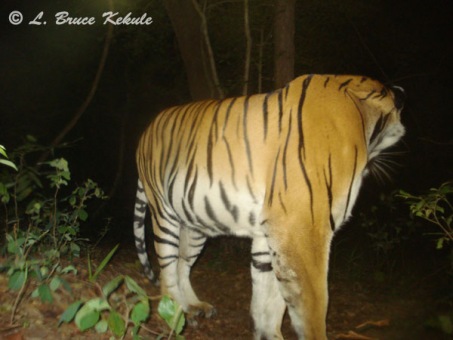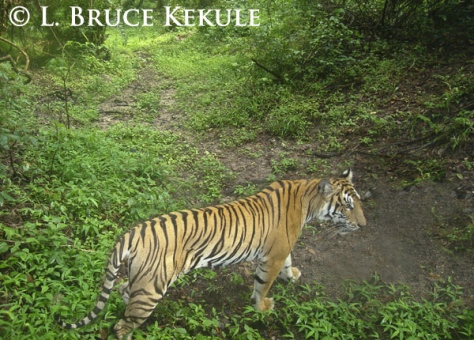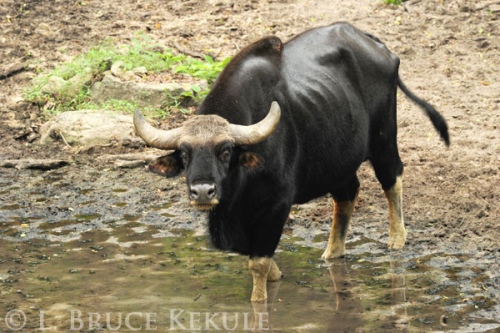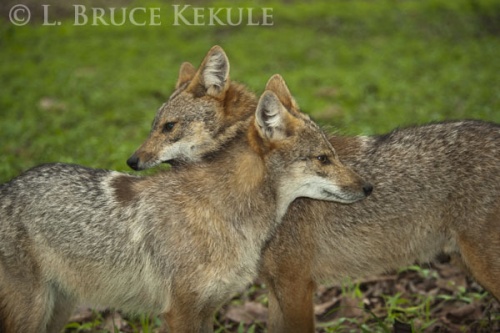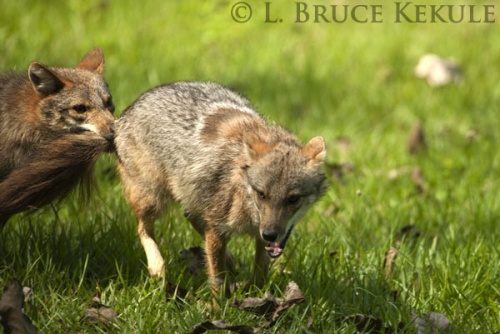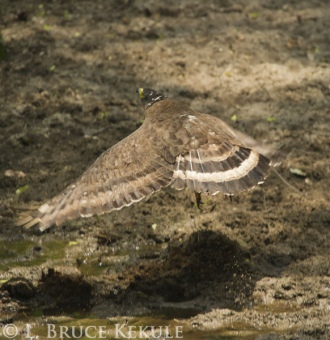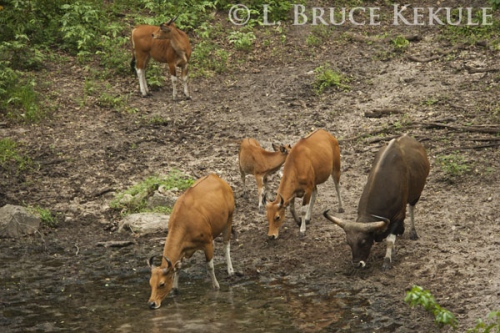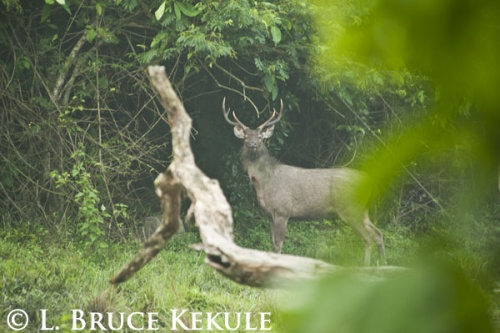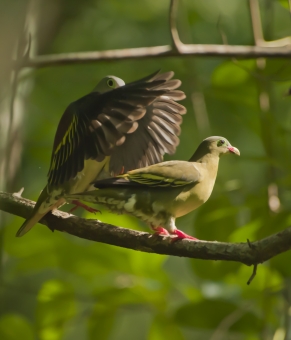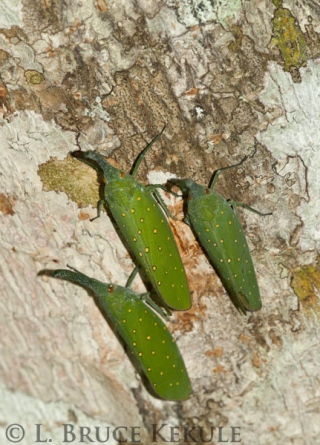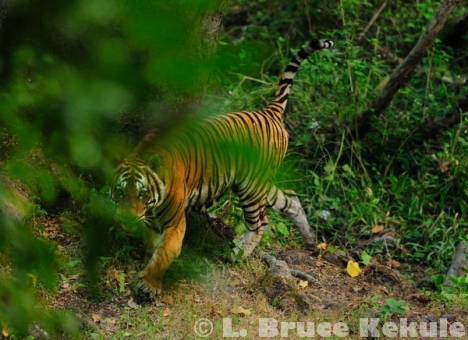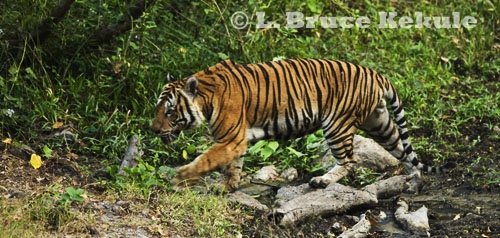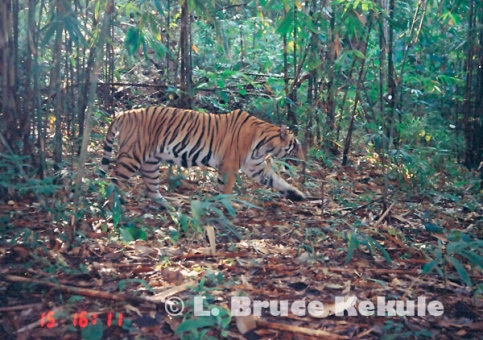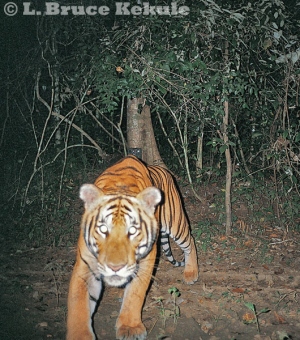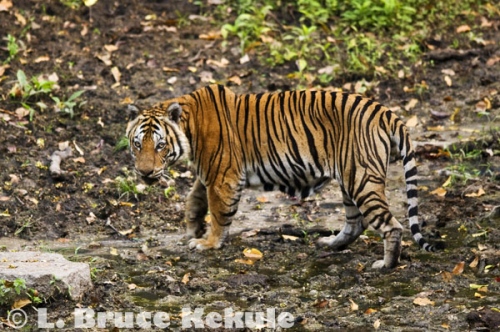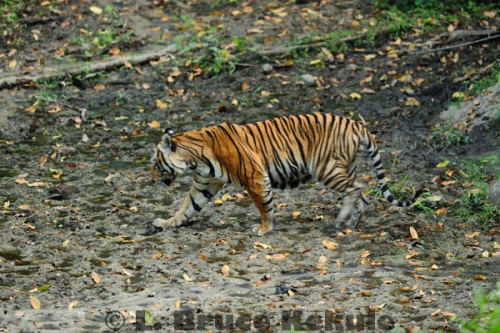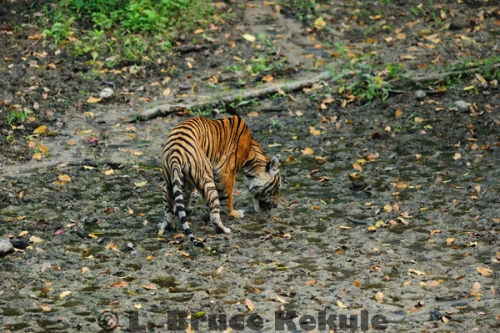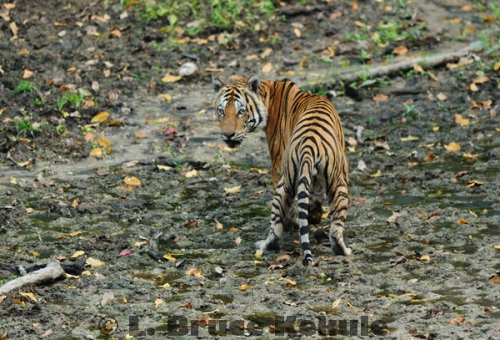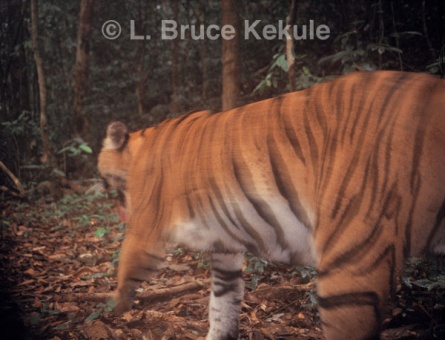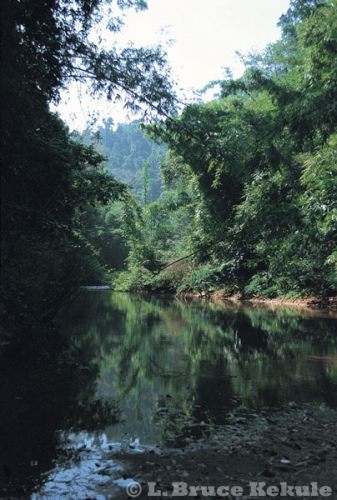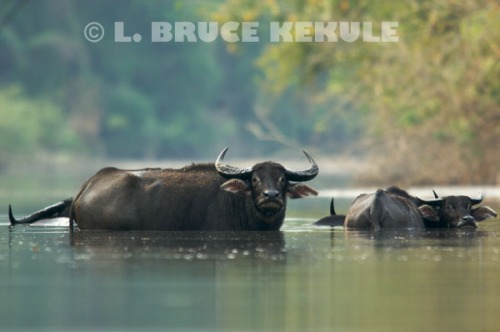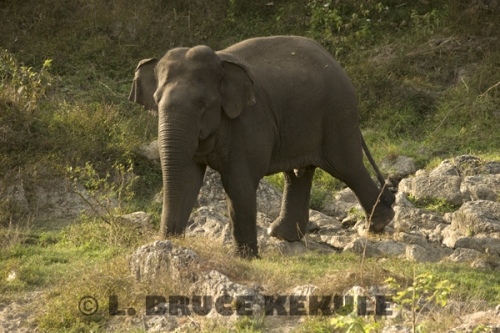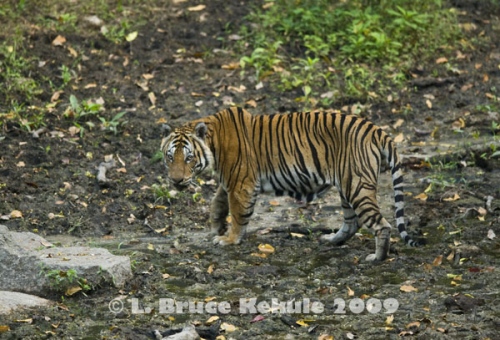Posts Tagged ‘Indochinese tiger’
Photogenic Indochinese tiger
This series of camera trap images of a young tigress was collected in Huai Kha Khaeng Wildlife Sanctuary with a Sony W55 homebrew trail cam during May of this year. This particular tiger does not seem bothered by the flash and I have caught her several times prior to this set. Some animals don’t mind flash while others do. I have a tiger on video growling and back-tracking after seeing the red-LEDs on a Bushnell Trophy Cam. I tend to believe it all depends on the individual animal.
Note the wound on her left flank and ticks in her ears.
Indochinese tiger camera trapped in Huai Kha Khaeng
An Indochinese tiger with a radio collar around its neck.
A big cat camera trapped in Huai Kha Khaeng Wildlife Sanctuary, Western Thailand using my BFOutdoors’ camera trap with a P43/1040/two ‘C’ cell externals.
There is an on-going scientific survey following some eight tigers in the sanctuary gathering data on their range and behavior. It has been proven in India that tigers with collars do not breed well and hence, I’m not too convinced the program is viable at this location. Also, the data on tiger numbers is not shared with the general scientific community and kept highly secret by a few individuals and an international conservation NGO. It is hoped that one day these collars (which must be very uncomfortable) will be removed to allow these magnificent cats to carry out their lives naturally.
Indochinese tiger sequence
The following images are my best of an Indochinese tiger caught in late afternoon in Huai Kha Khaeng Wildlife Sanctuary, Uthai Thani province, Western Thailand on December 11, 2009. This male moved through the waterhole and did not stay. I had just enough time to get 20 lucky shots of the big cat. A rare sighting of an elusive carnivore..!
Tiger moving into waterhole at 5 pm
Tiger takes a quick drink.
Tiger takes a first look at my location.
Tiger stops and take a second look.
Tiger moves on.
Tiger takes one last look.
The highlight of my wildlife photographic career and a dream come true….!
Photos taken with a Nikon D700 and a 400mm f 2.8 lens on a Gitzo tripod. Exposure: 1/60 sec; f/2.8; ISO 800
Chasing a Wild Dream
A video about Thailand’s Amazing Wildlife in the Western Forest Complex. From wild elephants to green peafowl, this film shows the world the wildlife in the Kingdom’s protected areas, and the need to save this wonderful natural heritage for present and future generations to come.
In the heart of Southeast Asia, the Kingdom is blessed with some of the best and last remaining examples of Asian animals and ecosystems that harbor the tiger, leopard, elephant, gaur, banteng, wild water buffalo, tapir, sambar, muntjac, gibbon, green peafowl, hornbill, plus thousands of other amazing creatures and biospheres that have evolved over millions of years and show-case Mother Nature and her magnificent beauty…!
Huai Kha Khaeng: A birthday tiger and leopard
A new Sony W55 trail camera catches the big cats
On May 19th (my birthday) 2012, I decided to celebrate in the forest after returning to Thailand from a two-week photographic safari in Africa. It was once again a great trip to the Dark Continent and I managed to photograph the ‘Big Five’ (three times now) plus a multitude of other animals including some rare species like black-mane lion, black rhino, striped hyena, sable antelope and bush baby. I also got many other common animals like elephant, buffalo, giraffe, zebra, warthogs and antelopes. I also managed to catch Mount Kilimanjaro when the clouds lifted. Kenya is absolutely one of the greatest natural spectacles on the planet and I look forward to returning next year.
A male leopard caught by a Sony W55 homebrew trail camera trap
However, there are still a few wild places in Thailand that harbor many magnificent Asian creatures such as tiger, leopard, elephant, gaur, banteng plus many other mammals, birds, reptiles, insects and plant species. Huai Kha Khaeng is one of the top wildlife sanctuaries in Southeast Asia, and the world for that matter.
Leopard caught again checking out the camera
To get there, it takes about five hours by vehicle from Bangkok and is tucked away in the forested mountains of central-western Thailand in Uthai Thani province. I have written many stories about this place and its wildlife, and it never fails to live up to its status as a ‘World Heritage Site’ but this time it turned out even better than my wildest dreams.
A young female tiger caught by the Sony w55 trail cam
My birthday wish to catch a tiger and leopard up-close with one of my camera traps was granted by the ‘spirits of the forest’ and all the hard work building the cams, setting them up, waiting while they soaked and then the pain-staking collection was truly worthwhile.
My favorite shot of this young tiger
Arriving early in the morning, I got everything ready and went out to check the cams. One location has been extremely productive and had been very lucky catching tiger and leopard almost every time (three months in a row). When I went through the photos on my new Sony W55/SSII/1020/3 AA externals, I could not resist shouting out loud with one big hurrah. A leopard had stopped at the cam for a few shots and a night later, a tiger posed for a whole series of close-ups from the low-down set-up. I was speechless for a few seconds.
Check-out the ticks and markings on the right ear
Remember this tiger eye and ear
This game trail is situated deep in the protected area and many animals use it to get to a mineral lick and waterhole. The balance of nature is in full force here and ‘eat or be eaten’ carries on everyday. There is a fallen tree right across the trail about 500 meters from the dirt road some 15 kilometers in the sanctuary.
More ticks and note the wound on the left shoulder
Both of these big cats jump this log as they hunt for prey but usually a few days or two apart. The leopard is a very mature male but the tiger is a young female that seems to may have finally left her mother. I have a close-up shot of this same cat captured together in March and identified it as the same tiger two months ago by markings on the right ear. What a coincidence!
Stripe-pattern on right side used to identify this cat
All I can say is: this has been the best birthday in many moons and I know that my prayers are really answered from time to time. It is hoped this young tiger will continue to live out its life in safety and carry on its legacy as the world’s largest cat. Huai Kha Khaeng is truly a remarkable place and I have not even scratched the surface of this amazing wilderness!
Escape to Nature – Photographing rare animals
Visiting the forest during Songkran: Thailand’s New Year and water festival
Huai Kha Khaeng reveals some wild endangered Asian creatures
Indochinese tiger camera-trapped in Huai Kha Khaeng
When I was 19 years old, I arrived in Bangkok at the end of March spending a week or so in the ‘City of Angels’ enjoying the sights and sounds. This was in 1964 just as the Vietnam War was getting into high gear. Pollution was mild and the klongs were not that bad.
I remember riding around in Datsun Bluebird taxis with no air-con and watching the road flash-by between my feet. The gaping hole made me nervous but the capital was an amazing experience all stored in the old memory bank.
Banteng bull and cow at a waterhole in Huai Kha Khaeng
After the hustle and bustle of the city, Dad and I caught the train headed north to Chiang Mai. The next morning at dawn, we passed through Phrae province surrounded by misty mountains. I opened the window and the cool breeze was refreshing. I instantly fell in love with the countryside and decided that Thailand was for me.
We arrived in the northern capital just in time to celebrate Songkran water festival for the very first time. As a teenager, it was a blast. But it was still tough getting around on my motorcycle as the main object of some people especially at intersections was to kill the bike, and then completely drench the rider (me) with water and powder.
Bull gaur arrived at the same waterhole a few minutes after the banteng
Yes, downtown Chiang Mai and the surrounding countryside was a madhouse even back in ‘64’. Songkran lasted for more than seven days in the north starting a few days before April 13th and finishing up a couple of days after the 15th.
As Thailand’s northern forests and mountains provided plenty of water for the festival, there was a seemingly unlimited supply. The watersheds were still very healthy at that time. In late March – early April, the temperature was cool in the evening and warm to hot during the day.
Crested Serpent-eagle flying out of the same waterhole
Eventually I met-up with some fellow Americans and the three of them are life-long friends to this day. John C. Wilhite lll was attending classes at the newly built Chiang Mai University, and his father was a Major in the U.S. Air Force for JUSMAG (Joint US Military Advisory Group) advising Royal Thai Air Force personnel on tactics and operation of AT-28 training aircraft. Johnny and I still continue to communicate after all these years.
Wayne (Beak) Sivaslian and Ed (Mac) McDonnell with the U.S. Army were stationed in Chiang Mai. Their mission was sensitive and classified but we were close friends and still are to this day. We recently held a 40-year reunion back in the States.
Asiatic jackals at a ranger station in the interior
When Songkran rolled around, we got out the old U.S. Army deuce and a half (2 1/2 ton truck) and took off the tarp and filling the back with three or four 200-liter drums with water and ice. We then headed downtown to do battle. As we were higher up than most, we had an advantage and usually won the water fights. At the end of the day, our lips, hands and feet would turn blue and we would be shivering but boy was it fun. Finally, the police outlawed trucks with large drums of water but that did not last long.
Asiatic jackal on the run
One year, I took my family including the wife and daughter plus all the in-laws out on the town in the back of my old Series One Land Rover with no cover, doors or windows. I was the driver and had to keep my wits about me. As we were nearing Suan Dok Hospital, a drunken hooligan dipped a bucket full of dirty klong water to the brim. He then threw the entire load straight into my ribs and face with extreme force from a distance of less than a meter, and that really hurt. All he did was laugh. However, with the family in tow, I kept my cool and carried on.
Asiatic jackal on the run
That was the last time I drove an open vehicle out on the streets of Chiang Mai during the festival. I once saw a bunch of people by the Ping River with a platform and fire-fighting nozzle in a tree, and a pump down by the water’s edge (obviously from the fire department nearby). After a day, the police came around and shut them down as they had damaged several cars with the high-pressure spray.
I went running through town with the Hash House Harriers a few times but again, it was even worse with water in my ears, eyes, nose, and usually contracting a serious cold afterward. I finally decided to retire permanently from the madness.
Abstract- Asiatic jackal on the run
Some may wonder why I am talking about Songkran in this post but it is the main reason I now ‘run away to nature’ every year to enjoy peace and quiet, the birds and bees plus the refreshing coolness of the deciduous and evergreen forests I frequent. No traffic jams or crazy water-throwing people here.
This year I was granted permission to enter Huai Kha Khaeng Wildlife Sanctuary by the Wildlife Conservation Division in the Department of National Parks (DNP) to photograph wildlife. It was a great opportunity and I made the best of it.
Jackal pair near the ranger station
Leaving Bangkok on the 11th of April, I arrived at the headquarters and met-up with the new chief Uthai Chansuk who was there to meet me. After consultations with him, I made my way into the interior with three other friends to a ranger station and settled in for a day.
A Thai friend and fellow wildlife photographer Sarawut Sawkhamkhet, has been with me on many occasions and knows this place well. He opted to sit in a permanent blind situated at a mineral lick close to the station.
Jackals chasing each other
My other two friends are Paul Thompson and Ian Edwardes, both Englishmen, and they set-up temporary blinds not far away. These two keen photographers got barking deer and a banteng bull on the very first day.
In the meantime, the rangers took me down to a platform overlooking a water hole and mineral deposit several hours walk away. We arrived at the blind about 10am and they went back to the station. I settled in for an overnight stay. I had plenty of water and food, and the weather was cool. Fortunately, my hammock fits perfectly between two trees that are part of the structure. This was April the 14th as the water festival was in full tilt.
Crested serpent-eagle taking off
The afternoon dragged on and about 2pm, a crested serpent eagle came for a drink. The raptor stayed for short while taking in copious amounts of water and then lifted off while I got a series of shots. About 5pm, as if the ‘Spirits of the Forest’ had granted my wish, a herd of banteng showed up coming straight down to the water hole for a refreshing drink. A huge bull with an enormous set of horns pushed his way through. I immediately began shooting my cameras. All of a sudden, they spooked and retreated up the hill. I thought they had scented me but this was not so.
Banteng herd at the waterhole in late afternoon
Just then, a huge mature bull gaur came down to the waterhole from the same direction as the banteng had come. Two species of large wild bovid in less than five minutes is simply amazing. This bull is very old with many rings at the base of his horns with both tips almost completely worn down. Definitely near the end of his life.
Gaur bull taking a drink at the waterhole
Dr Sompoad Srikosamatara at Mahidol University and Dr Naris Bhumpakphan at Kasetsart University estimated this solitary bull to be somewhere between 14-16 years old judging from the amount of rings. This old boy stayed at the waterhole for more than a half hour taking in his fill. He then snorted and bolted up the hill looking extremely powerful and quick on his hooves.
Lone gaur bulls will sometimes shadow a banteng or gaur herd for protection against tiger attack and poachers. They also sometimes team-up with other bulls. Simply put, more eyes, ears and noses act as security from predation.
Wild pig at the waterhole just before darkness
However, it was not my scent that had spooked the ungulates as a mature wild boar with large tusks then came for a drink just before darkness. Eventually, night set in. I had my little gas stove and boiled up some water for noodles and coffee. After eating, lightning and thunder began in the west but eventually subsided. The weather was nice and crisp, and I slept like a log.
Mineral hot spring deep in the interior of Huai Kha Khaeng
The next morning, I was up at daybreak. After a quick cup of coffee, the banteng herd from the previous day came to the waterhole again. This time they stayed for some time taking in refreshment. Funny enough, the bull had a leafy branch stuck between its left ear and horn. I of course kept shooting until they had gone. These cattle are rare in Thailand and tough to see in the wild. Banteng are a favorite wildlife subject and I felt lucky.
Sambar stag in a mineral lick in the interior
At noon the next day, the rangers and Thompson came to pick me up. Before leaving, we set camera-traps around the mineral deposit leaving them for a month. A young Indochinese tiger visited one of my cameras catching it in a broadside pose shown in the lead photo. This shot is one of my best tiger camera-trap captures ever, as it is close and in beautiful light early one morning just after Songkran.
Young sambar stag at another mineral deposit
Back at the station two Asiatic jackals that had been released by someone who had kept them in captivity were romping about. They have now made the area their home. I was able to get some exciting photographs of these two wild canids as they scavenged around the station. The pair, a male and female, once brought a deer leg from a carcass nearby and devoured it. They certainly have adapted to a life in the wild but are not afraid of humans.
Wild pig and piglets at a mineral deposit
A day later, we moved to a hot springs deep in the interior. Here, we photographed wild pig and sambar. As the rains have come early this year, insect activity is already in full swing. Thompson and I got out our macro lenses and had a great time chasing down the little creatures. We both photographed several new species for us including a lantern bug. The trip finally came to an end and we left the sanctuary with loads of new photographs showing the amazing biodiversity of this place.
Thick-billed pigeon at the hot spring
I know I have written many times about Huai Kha Khaeng in this column, but as the nation’s top wildlife sanctuary, it needs special attention and its continued survival cannot be stressed enough. More work is needed to improve protection with everything else taking a backseat like research and development. Ranger patrolling should be more consistent with revolving teams to create no loopholes for poachers and gatherers. Better budgets and personnel are the key.
Tree frogs mating in a pool on the road in the sanctuary
Thailand contains some of the most beautiful habitats and creatures in the world. The Kingdom is home to more than 70 million people, yet it supports an incredible variety of wildlife. However uncertain the future of the country’s wild flora and fauna may be, their presence today remains a spectacular, intriguing and mystical natural wonder.
Orb web spider at a ranger station deep in the interior
Lantern bugs at the same ranger station
*************************
The Indochinese Tiger: Lord of the Jungle
Wild Species Report
Thailand’s mystical cat – A rare striped carnivore and awesome natural predator
Falling leaves signals the dry season has arrived and the forest floor is carpeted with a mosaic of green, yellow, brown, red and orange. A large predator walks the trails seeking its next meal. A barking deer sensing danger barks a warning. The whole community of wild animals is on alert as squirrels and monkeys cry out from the trees above. A striped carnivore stalks a herd of wild pigs. The nervous omnivores squeal and panic, running through the underbrush to escape. But the big cat is quick as lightning – it catches a young pig with sharp claws. The struggle is over in seconds as fangs penetrate to the spine.
Indochinese tiger Panthera tigris corbetti in Huai Kha Khaeng
A tiger has just made a kill. It lifts the lifeless pig into deep cover and devours the carcass. After feeding, the big cat will seek water for a thirst quenching drink. It will lie down and rest until the desire to eat or drink begins again. Tigers sometimes move great distances in search of food. But where there is an abundance of prey, tigers continue to live in balance with nature. The average kill ratio is about twenty unsuccessful attempts to one kill. At a certain time of year, the male tiger will seek out a female in estrus to carry on his legacy.
Some two million years ago, the tiger evolved in Northern China and Siberia, and spread to many parts of Asia all the way to the Caspian Sea and eastern Turkey in the west. The Himalayas stood as a serious barrier to their migrating into India. Some reached Korea and Manchuria, and also advanced south through China then into Indochina, and down to the islands of Sumatra, Java and Bali. Tigers are good swimmers and made it across narrow sea channels. About 10,000 years ago, the big cat moved west through Burma and Bangladesh on to India. At one time, there were probably more than a hundred thousand of them throughout the tiger’s world range.
Tiger on the prowl in late afternoon
A century ago, Thailand was an absolute haven for this carnivore. They could be found in every forest within the Kingdom. But as humanity expanded, the species quickly declined because of human predation, and loss of habitat and prey animals. The pelt is sought after by hunters and its bones wanted by Asian medicine practitioners. Many considered this predator a pest and as modern weapons became available, and humans expanded into the forest, these magnificent beasts really began to vanish. Realistically, it is estimated there might be about 200 to 300 tigers left in Thai forests, which unfortunately, is barely sustainable over the long run in some areas. However, a very few protected areas if properly taken care of, could sustain a population of tigers. Thailand still retains some of the best-protected tiger habitat left in Southeast Asia. Wildlife corridors between protected areas are one of the most important keys to sustainability.
Feral cats caught by camera traps on a wall behind my home
When I began wildlife photography, the burning desire to photograph a tiger in the wild was one of my great wishes. These cats are extremely difficult to see let along photograph. My real first encounter with a tiger was in Sai Yok National Park in western Thailand back in 1996. I was sitting in a tree-blind when one jumped across the stream behind me and I caught a very brief glimpse of the sleek cat as it moved downstream hunting for prey. From that day on I photographed many other wild creatures including the leopard, but never a tiger. I was beginning to doubt whether I would ever photograph one.
My first camera trapped tiger in Sai Yok National Park
Several years later coming back to Sai Yok, I began a camera trap program not far from the headquarters. This was in mid-October 2003. Six traps were set-up in the forest at waterholes and game-trails. As we were breaking camp, the cook asked me for a lucky number. I just lifted my camp chair that left two impressions in the dirt like the numeral 11, and so I called out 11.
My second camera trapped tiger in Sai Yok
A month later, the film and batteries were collected and after processing, I saw two tigers on film. The first was an old male caught at a waterhole on the 11th day of the 11th month that was recorded on the frame. Three days later, a younger male tiger passed another camera up on a 600 meter ridgeline on the 15th at 16.11 pm also imprinted in the frame. Some may say it was just a coincidence to have the number 11 in both photos, but I like to think the ‘spirits of the forest’ had finally answered my prayers.
Tiger camera trapped in Kaeng Krachan National Park
Further south along the Tenasserim Range in Kaeng Krachan National Park at the beginning in January 2001, I began another camera trap program in conjunction with World Wildlife Fund for Nature (WWF) and the Department of National Parks (DNP) at two locations in the park. The first was along an old logging road not too far from the main gate at Sam Yot. During a four-month period, many animals were captured on film including an amazing six photographs of one mature male tiger. He actually came right up to the camera trap for a facial portrait, and then walked away. That was the beginning of a very successful ‘presence/absence’ program carried out (2001-2004) to determine if tigers and other large mammals were still surviving here.
Tiger male hunting on an old logging road in Kaeng Krachan
The second area was along the Phetchaburi River that flows crystal clear through this magnificent forest. Many tigers walk the elephant trails hunting for prey. My very close friend Sutat Sapphu (a forest ranger with incredible knowledge of this ecosystem) and I began a monthly program setting up more than 20 cameras along the river. One particular individual tiger named ‘four-spots’ due to a marking on its left flank was caught down near a crocodile pond where he actually tried too bite a camera trap and we got a shot of his mouth and whiskers. Over the next few months, ‘4-spots’ was captured up and down the river, and then way up Phanern Thung Mountain at 900 meters by the road into the park at kilometer 28.
Tiger camera trapped on old logging road in Kaeng Krachan
When the road was closed in Kaeng Krachan due to heavy storms and landslides in October 2003, four-spots was consistently camera trapped at kilometers 33, 34 and 35, and down at the infamous ‘KU’ camp by the river. The distance was calculated to be about 22 kilometers apart. Several other male and female tigers were recorded over the three-year program and are a testament to the remarkable biodiversity of Kaeng Krachan. Many other creatures were also caught including tapir, leopard, wild dog, fishing cat, sun bear, the rare Fea’s muntjac, elephant, gaur and serow among others. Returning in November 2008, and now using a digital camera trap, I got a tiger in November at a mineral lick just 12 kilometers from the front gate.
Tiger up-close in Kaeng Krachan
Good things sometimes come our way and I was about to get a reward to coincide with ‘2010-The Year of the Tiger’. The absolute chronology of being at the right place, the right time with the right equipment and the right technique was played out before my eyes. On the 11th of December 2009 (my lucky number again), the tiger in the lead photo and I crossed paths. I was lucky to have been sitting down with my hands on my lap right in front of my camera. If I had been standing, or made just the slightest noise, I would have never seen this old male.
Indochinese tiger on the prowl at night
The trail through dry dipterocarp forest takes about a 40 minute walk to a photographic blind set above a mineral deposit deep in the interior of Huai Kha Khaeng Wildlife Sanctuary, Thailand’s top protected area and World Heritage Site situated in western Thailand. The flimsy structure made of bamboo sits about two meters off the ground and is attached to a tree. Black mesh closes off the cubicle on all four sides that was erected by the park rangers. An opening large enough for a big lens allows a clear view of the waterhole some 50 meters downhill to a saucer shaped depression.
Tiger at night by the Phetchaburi River
This waterhole attracts many creatures such as elephant, gaur, banteng and other ungulates like sambar and wild pig. Tiger, leopard and Asian wild dog also come looking for prey. It is truly a magical place and a tribute to Thailand’s natural biodiversity. Arriving about 12pm, I immediately set-up my cameras and then waited. Feeling dozy, I strung my hammock for a bit of a snooze after the long haul from Bangkok. The afternoon passed-by slowly and about five got up and began a vigil of the mineral lick. A few minutes later decided to actually sit behind my 400mm lens and camera, and do some adjustments to compensate for the fading light. Took a few test shots to make sure the exposure was correct and then waited. Two minutes later, the dream of a lifetime unfolded before me.
Same tiger a month later during the day at the above location
A striped carnivore magically and silently appeared from the forest on my right. The tiger walked straight down to a little stream for a quick drink. The mature male did not linger and continued on his way. However, he did pause briefly to stare up at my position three different times before disappearing into the forest on my left. Total time spent by the cat at the waterhole was less than a minute. I was extremely fortunate to snap 20 frames as the magnificent creature carried on its way. I banged my head against my camera in disbelief to make sure I was not dreaming. After 15 years of wildlife photography, my aspiration to photograph a tiger through the lens has finally come true.
A female tiger in early morning at the same location
The present status of the tiger in Thailand is balancing on the beam of nature. As a World Heritage Site, Huai Kha Khaeng and Thung Yai Naresuan wildlife sanctuaries is the core area and absolutely the last great tiger haven in the Kingdom, and Southeast Asia for that matter due to its size (6,427 square kilometers), and its biodiversity. In Huai Kha Khaeng, the Department of National Parks has really improved the situation with better patrolling, increased help for the rangers, a demarcation fence along the eastern buffer zone in Uthai Thani, constant vigilance by many people and NGOs’ plus improved management, wildlife research and better awareness education. With these measures in place, prey species have come back and are now abundant. Tigers are thriving. There are about a hundred in the Huai Kha Khaeng-Thung Yai block.
Male tiger posing for my camera
Research on the tiger has been carried out by the Wildlife Research Division under the direction of Dr Saksit Simcharoen and his staff in conjunction with several other people and organizations including Dr Ullas Karanth (from India) and Dr Dave Smith from the University of Minnesota.
A waterhole with mineral deposits in Huai Kha Khaeng
Dr Saksit and others has published a paper in the science journal Oryx (How many tigers Panthera tigris in Huai Kha Khaeng: An estimate using photographic capture-recapture samplings) to establish a number. According to Dr Saksit, the home range of the Indochinese subspecies is about 240 square kilometers. Dr Peter Cutter with WWF-Thailand, and also a student with the University of Minnesota, has done his doctorate thesis on ‘tiger’s occupancy monitoring’ using transect and trail sign data gathered in Huai Kha Khaeng.
Tiger entering waterhole
Camera trapping is still by far the best and safest way to establish a home range of a tiger due to its individuality. No two tiger’s striped pattern is alike. It is imperative to use opposing camera traps to get a picture of both sides to identify individuals. Footprint and scat analysis are also very good techniques.
Tiger drinking from shallow stream
In my opinion, collaring a tiger is extremely dangerous as the capture process could possibly injure or impair the animal. As rare as they are, it does not justify losing even one of these magnificent creatures to a possible botched captures and release. Some researchers may not agree but eight tigers in Huai Kha Khaeng have already been collared and ranges determined. You can only get so much data. Loads of tiger home range information has also come from India and elsewhere. I’m all for good passive scientific research (wild animals are not handled at all) carried out to save the tiger.
Tiger looking back at my position
The Western Forest Complex includes 17 protected areas encompassing more than 18,000 square kilometers and has the potential to accommodate 700 tigers. Even though this estimate is high, with good protection and patrolling in all the protected areas in the complex to keep poachers out and encroachment to zero, and to protect the prey species or food chain for the tiger, it is feasible in the future this number could be a reality. However, due to serious fragmentation with roads, dams and reservoirs plus humanity and agriculture, it will be a difficult road ahead unless the present boundaries of the large protected areas stay intact and unharmed, and more corridors set-up through national forests. The World Heritage Site of Huai Kha Khaeng and Thung Yai must be the number one priority of the DNP as a conservation area.
Tiger on the move
For the long run, forest protection and wildlife awareness education to all levels of society is the key to saving the Kingdom’s natural heritage. The government should always strive to use all its resources to keep the forest and wildlife free from the damaging effects of human intervention. The private sector and the government need to be aware of all the problems regarding the forest rangers and try to improve their lives. The forest can be a deadly place to work and these men need incentive, as they put their lives on the line.
Tiger’s final look before disappearing into the forest
Projects to provide food and clothing to help these men are being carried out in a few protected areas by a few individuals, companies and organizations. Without dedicated ranger patrolling, tigers will surely slip away. It is up to the present generation to take proactive measures to make sure Thailand’s wild flora and fauna stays intact for future generations to see, enjoy and cherish.
Ecology and behavior of the Tiger:
To understand how the tiger evolved, we must go back to the beginning of these wild creatures. Nimravidae were the first cats to evolve in the Early Oligocene epoch, about 35 million years ago. They lasted till the Late Miocene, some eight million years ago, when huge grasslands had developed around the world. The large saber-toothed cats were the first of the family Felidae. These long-fanged felines evolved alongside huge herds of grazing mammals like antelope and cattle. There were several different species of saber-tooth, but they all became extinct about two or three million years ago.
Modern cats belong to the family Felidae which includes: tiger, lion, leopard, cheetah, and domestic cats. Ultimate carnivores, they feed almost exclusively on vertebrate prey and sit at the top of the food chain. Wild cats have few predators apart from man. The tiger belongs to the genus Panthera or roaring cats that also includes the lion, leopard and jaguar.
Tiger camera trapped abstract
The Indochinese tiger Panthera tigris corbetti was named after Jim Corbett, the famous conservationist and hunter of man-eating tigers and leopards in India during the 1930s’. This subspecies is found in Thailand, Vietnam, Laos, Cambodia, eastern Burma and southeastern China. According to Chatchawan Pisdamkham, Director of the Wildlife Conservation Division of the DNP, there are approximately 250-300 tigers left in the wild of Thailand.
The following protected areas still harbor these magnificent felids: Huai Kha Khaeng, Thung Yai Naresuan, Umphang and Salak Phra wildlife sanctuaries plus Mae Wong, Sai Yok, Sir Nakarin, Erawan, Kaeng Krachan and Kui Buri national parks in the west; Khao Yai, Thap Lan and Pang Sida national parks, and Phu Khieo wildlife sanctuary in the Northeast, and Hala Bala Wildlife Sanctuary in the deep south.
Tiger camera trap abstract
It is doubtful if any tigers survive in the protected areas of the north or Khlong Saeng-Khao Sok forest complex in the south as no reports have come from these areas for many years. Eastern Thailand has no tigers on record. A couple of years back, the newspapers reported on tiger tracks found not far from the road around several national parks in Chiang Mai and Lampang but were fake put down by a prankster to stir-up media frenzy. This was supposedly to help villagers who had lost cattle to a predator, more likely feral dogs.
Tigers are essentially solitary but come together when a female is in estrus. The resident male will copulate with a female many times over several days. Gestation ranges from 93-114 days. Litters can be from one to seven but usually only two to three cubs survive. Tigresses rarely accompany more than three cubs in the wild and abundant prey is required for a growing family with a small home range about 60 square kilometers.
Indochinese tiger tracks in Kaeng Krachan
It has highly developed vision about six-times more powerful than man and an extreme sense of hearing. These attributes are essential in locating prey. The feed almost exclusively on herbivores and are at the top of the food chain.
Indochinese tiger habitat in Kaeng Krachan
The tiger’s ultimate advantage in stalking prey is its striped pattern that is natural camouflage and this cat is a very efficient killer. It has awesome strength and unmatched armament of retractable claws, long fangs and dagger-like canines. It can sometime dispatch animals as large as gaur, wild water buffalo and small elephants. Tigers have no predators other than humans.



